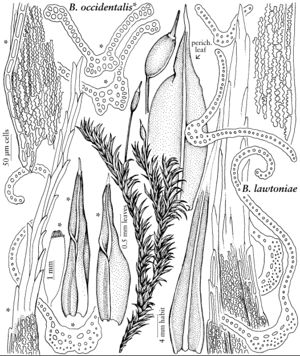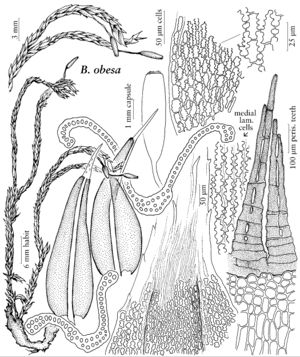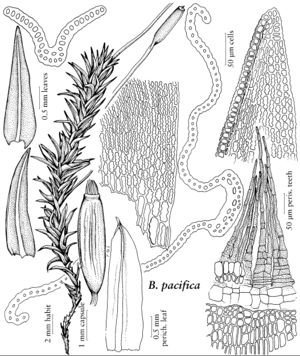Bucklandiella
Ann. Bot. Fenn. 9: 116. 1972,.
| Taxon | Illustrator ⠉ | |
|---|---|---|
 | Bucklandiella lawtoniae Bucklandiella occidentalis | Patricia M. Eckel Patricia M. Eckel |
 | Bucklandiella obesa | Patricia M. Eckel |
 | Bucklandiella pacifica | Patricia M. Eckel |
Plants small to large, in loose or compact tufts or forming extensive paches or mats, green, brown, yellowish, olive green, less often blackish brown or occasionally jet-black. Stems erect, decumbent or creeping, much dichotomously to irregularly, sometimes (sub-) pinnately branched, rarely almost simple and unbranched. Leaves lanceolate, oblong or ovatelanceolate, concave proximally, canaliculate to carinate distally; margins 1-stratose to variously multistratose, variously recurved to revolute on one or both sides, entire; apices acute or occasionally narrowly obtuse, entire or very seldom crenulate, long-piliferous to short-hyaline-tipped or sometimes epilose, if present, hyaline to yellowish hyaline, never papillose; costa single, percurrent, semiterete in the distal and median parts, reniform to strongly flattened in the proximal portion, 2-to multistratose, with 2 to many enlarged, adaxial epidermal-cells and small, substereid or stereid central and abaxial cells; laminal cells 1-stratose throughout or variously multistratose in the distal half, with moderately to strongly incrassate, sinuose to nodulose lateral walls, smooth or often pseudopapillose; basal laminal cells elongate, long-rectangular to linear; distal laminal cells quadrate, roundedquadrate, oblate to rectangular. Inner perichaetial leaves not or strongly modified, often entirely hyaline to yellowish hyaline. Seta 1–3 per perichaetium, erect, twisted clockwise distally, smooth. Capsule brown, castaneous or blackish brown, straight, symmetric, ovoid, ellipsoid, obloid to narrowly cylindric, narrowed at the mouth, without or with an indistinct neck; exothecial cells variable in size and shape, subquadrate to oblong, with thin to thick, straight or flexuose walls; annulus compound, abruptly or tardily deciduous, 2–4-seriate; operculum straight or slanted, conic-rostrate or long-rostellate; peristome teeth lanceolate to triangular, reddish-brown or brown, cleft into 2–3 filiform, terete prongs in the distal half, occasionally 2-fid nearly to the base. Calyptra 4–5-lobed at the base, naked. Spores spheric, finely granular to coarsely papillose.
Distribution
North America, Central America, South America, Eurasia, Africa, Atlantic Islands, Pacific Islands, Australia, Antarctica
Discussion
Species ca. 50 (12 in the flora).
Bucklandiella is the largest and taxonomically most difficult segregate of a broadly conceived Racomitrium. It is a clearly defined and easily recognized taxon that, in contrast to the other three segregates of Racomitrium, comprises taxa with smooth laminal cells. There may be pseudopapillae, due to numerous longitudinal cuticular ridges that make the leaf surface rugged and appear papillose in transverse-section. The smooth laminal cells are coupled with relatively short, lanceolate or triangular peristome teeth, which are irregularly divided in the distal half into 2–3 or occasionally 4 branches, which however, are sometimes only irregularly perforated along the median line. In some cases the teeth remain undivided. Additionally, the following combination of characters is typical of this genus: narrowly lanceolate to ovate-triangular leaves; unbranched, percurrent costa; awns, if present, smooth, denticulate, or spinulose but never papillose; leaf margins 1–2(–4)-stratose in one to several cell rows; and seta always smooth, twisted to the right when dry.
Selected References
Lower Taxa
Key
| 1 | Leaves noticeably spiral-ranked around the stem when dry; perichaetia and sporophyte unknown | Bucklandiella sect. Marginatae |
| 1 | Leaves never spiral-ranked when dry; perichaetia and sporophyte known | > 2 |
| 2 | Innermost perichaetial leaves similar to the vegetative leaves, moderately sheathing proximally, chlorophyllose, acuminate and piliferous distally; leaf awn erect-recurved to squarrose, not flexuose when dry | > 3 |
| 2 | Innermost perichaetial leaves not similar to the vegetative leaves, sheathing, obtuse, not or shortly apiculate, occasionally with a short awn but then the basal leaf cells with incrassate, porose and nodulose lateral walls; leaf awn erect, usually strongly flexuose when dry | > 4 |
| 3 | Large, yellow-olivaceous plants usually with a long awn, awn long-decurrent | Bucklandiella sect. Lawtonia |
| 3 | Smaller, greenish or brownish plants with a short awn, awn not or only slightly decurrent | Bucklandiella sect. Sudeticae |
| 4 | Innermost perichaetial leaves hyaline proximally, fairly large, chlorophyllose distally with an areolation of cells with strongly incrassate walls; basal leaf cells not sinuose, with nodulose, porose and strongly incrassate walls. | Bucklandiella sect. Marginatae |
| 4 | Innermost perichaetial leaves hyaline or yellowish hyaline throughout, often fairly small; basal leaf cells sinuose. | Bucklandiella sect. Laevifoliae |